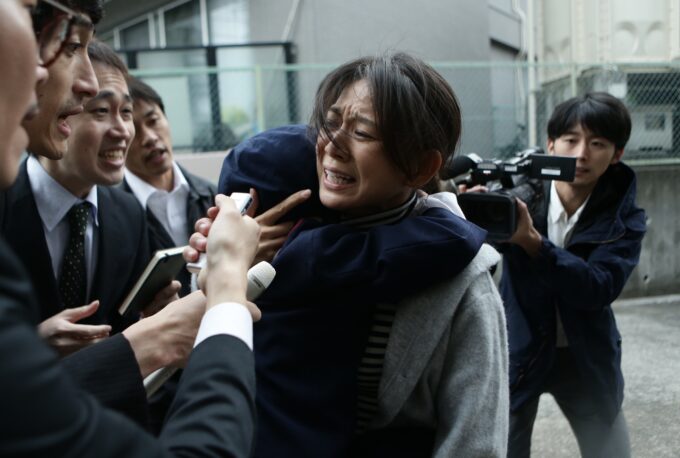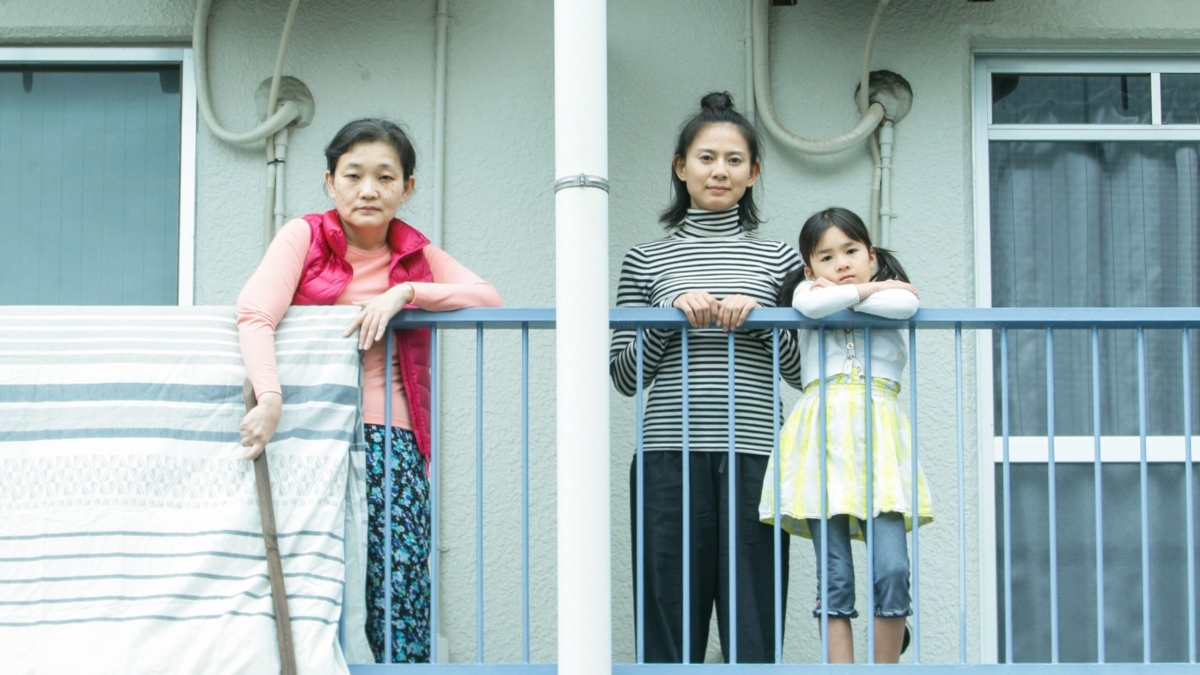Written By: Jeremy Lim
Disclaimer: This article may contain spoilers.
Amano Chihiro, takes a simple, rather played-out scenario and stretches it to its limits. While exploring family drama, life in the modern age and slapstick comedy, Amano manages to find a fine balance between the quiet moments of life and the absolutely bombastic.
“Mrs. Noisy” follows Yoshioka Maki (played by Shinohara Yukiko), a mother and writer, as she moves into a new home with her husband, Yuichi, and her young daughter, Nanako. We see the day to day goings-on of Maki as she becomes more and more frustrated with the way her life is going.
Maki, known also by her pen name Mizusawa Rei, is a writer of the “starving artist” variety. She had one massive hit novel when she was much younger before petering off into obscurity, a clean-cut example of a one-hit wonder. While dealing with the failures in her professional life, Maki struggles to also take care of Nanako and also handle her household chores. The pressure and anxiety in her begins to swell when the human embodiment of the straw that broke the camel’s back appears, the titular “Mrs. Noisy.”
Mrs. Noisy, or Wakata Miwako if you prefer using her God-given name, is the name that Maki gives her rather rambunctious neighbor: a woman that appears to have no sense of courtesy, common sense or empathy. She lives with her suspicious-looking husband, Shigeo, and the two are shown as rather strange people. Maki’s very first interaction with her is Mrs. Noisy beating of her futon over and over again in the wee hours of the morning as Maki tries desperately to finish manuscripts that she knows won’t sell.
The situation slowly escalates as we not only see that same futon encounter a couple more times but also some singing and a loud boom box into the mix. Eventually everything comes to a head when Maki accuses Mrs. Noisy and her husband of “kidnapping” Nakako, the emotions of both sides running extremely high.
This encounter is ripped straight from the headlines, when in the early 2000s, a woman tried to get her neighbor to move by banging on a futon and playing loud music on a boombox. The story picked up major traction in Japan and the situation has been parodied to death. But, instead of just making fun of the old lady over 100 minutes and calling it a day, Amano decides to do what nobody seemed to be able to do before, sympathize with the woman. This is one of the main themes of “Mrs. Noisy,” the idea that, maybe, just once in a while, we need to take a step back from ourselves and think about what others may be going through.
The film can be split into two major sections, with each section feeling very different tonally. The first section of the film feels a lot lighter, a lot more easy-going. Maki struggles juggling her family life with her professional one, but it’s all played off with a sort of comedic fluffiness that overshadows even the most serious moments, like when Maki and her husband Yuichi have a fight on Nakako’s birthday right in front of her. Sure, the family is dealing with a lot, and it’s not really something to laugh at, but it could be worse. The situation is far from perfect, but it’s undercut with a certain “slapstick” feeling that keeps you in this dramedy mindset. At one point, Maki and Mrs. Noisy have a grand chase around their apartment building over a pseudo-food fight. If the Benny Hill theme song was played over the scene, it would feel right at home.
However, as Maki decides to blend reality with fiction and begins to write about her battles with her neighbor to advance her professional career as a writer, the film shifts gears completely. We jump back to the beginning of the film. The central character is now the noisy neighbor herself, Miwako, and the film’s real messaging starts to take shape through moments of suffering and hysteria. This is where I think the film really manages to grab and hold my attention. The more light-hearted moments of the first half elicit some hearty chuckles and cracks a smile on my face, but Amano flourishes when she juxtaposes that with moments of the mundane, the quiet, and the absolutely devastating.
At first, when we follow Maki and her family, the world feels rather bright and lively, the setting and the characters pop. When we start to follow Mrs. Noisy and her world, though we go over the same settings and chain of events that Maki encountered, everything feels different. Their world feels a little more dull, a little more empty, but a lot more real. We feel for these characters that we just spent thirty or forty minutes absolutely lampooning; we learn that perspective is so important when thinking about others. Mrs. Noisy is no longer that evil hag that Maki sees her as. Instead we feel for her situation deeply and we recognize her struggles, not as a character in somebody else’s story or a caricature, but as a wife, a woman and a human being. We see her caring for her husband who deals with mental health problems, going out of her way to help people at work, and, most importantly to the plot, helping Nanako in her time of need when Maki fails to do so.
This perspective switch shows skill in story-telling and characterization, stringing the audience along and flipping the feelings and emotions of the audience. It’s almost like we are being meticulously set up, having us think, “Wow, aren’t these guys just the worse?” before flipping the narrative and showing us the errors of our ways. “It’s about the core of the story. People and events aren’t in black and white. They are more diverse, multi-sided, and vague,” Maki’s editor says to her, giving her advice on how to write realistic characters. Amano hammers home her point: don’t judge a book by it’s cover.
She does this not only through an earnest look at Mrs. Noisy and her husband but also through her framing of shots and her use of light and darkness. At one point, in a scene where Mrs. Noisy and her husband are particularly vulnerable, the husband and wife are left crying on the floor, curled up in a ball, with the camera moving away from them. The couple slowly becomes smaller in the frame as they feel more alone in the world.

The idea of empathy and caring for others is further developed with the nuance of social media and cancel-culture added into the mix. Maki and her neighbors are placed in the middle of a massive media frenzy when their neighborly feud goes viral, and even though Maki initially benefits from this, both families end up in shambles. The media likes to portray stories with clear villains and heroes for the viewing audience to grasp onto easily. One side always has to be evil incarnate while the other side is always portrayed as holier than holy. It’s easy to do this when you dehumanize the people we put in front of our television cameras. This is exactly what Amano portrays in this film, having two families duke it out for the viewing pleasure of others until people just stop caring. Mrs. Noisy, in a particularly poignant moment in the film, sits in the darkness of her room, turns to her husband and says, “Recently, too many unreasonable things, I’m sick of it. The world’s too narrow-minded, too unsociable.” The world has turned on these characters rather easily because nobody stopped to think about them as human beings. This modern-day structure of mass communication that the film spotlights makes it very easy for people to disregard people like Maki and Mrs. Noisy.
This concept isn’t really all that special or earth-shattering, as more and more people daily are starting to question social media and its true value within society, but what makes this film just a little bit different is that we get to see the aftermath of it all. The fame and media spotlight might fade quickly, but even though the general public might stop caring about Maki and Mrs. Noisy once they’re done with them, we soldier on and continue to follow their lives because the film reminds us as viewers that just because the news cycle is over, that doesn’t mean we get to sweep their lives under the rug. Amano makes sure that, even if only for a brief moment, the viewing audience questions whether or not they are being sympathetic enough in their own lives. As much as we like to think we’re perfect beings and so much better than everyone else, it’s just not the case. We can either choose to look for the flaws in other people’s lives or we can make a concerted effort to place ourselves in other people’s shoes.
Whether dealing with family drama, media outrage, or even the role of the working woman in Japan, Amano Chihiro portrays everything with a touch of gentleness. She’s able to show characters in detestable positions, doing detestable things, without losing complete sympathy for a situation. “Mrs. Noisy” may not be setting the world ablaze with cutting edge schools of thought, but simplicity shines in this film. The film wears many hats in regards to what it’s trying to say but it can really all be boiled down to this: be a good neighbor.
“Mrs. Noisy” is screening at the 43rd Asian American International Film Festival. Ticket and screening information can be found here.

